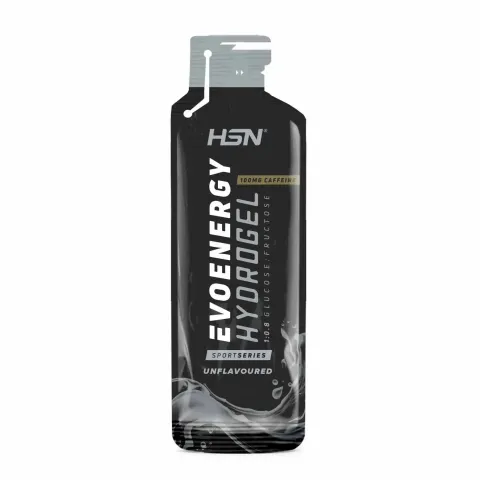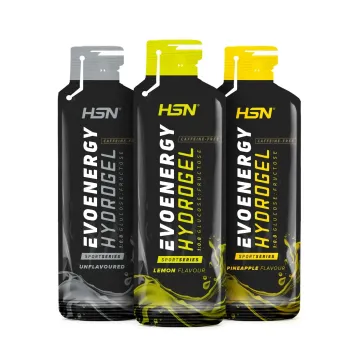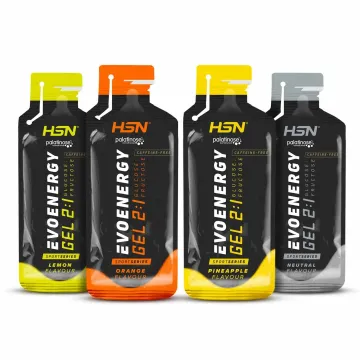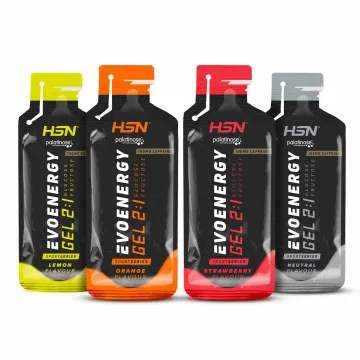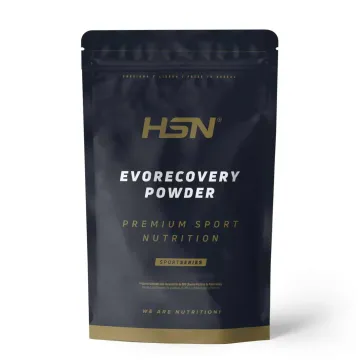- Discover HSN Hydrogels! The lightest presentation of energy gels for use during races.
- Caffeine version - Ideal for use in the first part of training.
- 100mg of caffeine per gel - Equivalent to 1.5 cups of coffee, without digestive discomfort.
- Light texture - Mild flavour (not salty, controlled sweetness) - Easy to consume.
- Naturally sweet development! Thanks to its carbohydrate content, no sweeteners.
- 0% digestive discomfort | Does not dry out your mouth | The perfect complement to isotonic drinks.
- 43% carbohydrate content - With 120mg of sodium per gel for electrolyte replenishment.
- Glucose : Fructose ratio (1:0.8) - The most recommended proportion for high carbohydrate intake.
New HSN Hydro Gels! Available in caffeinated and non-caffeinated versions
Evoenergy Hydrogel with Caffeine from SportSeries is the caffeinated version of Evoenergy Hydrogel, high osmolality carbohydrate and electrolyte gels with a more moderate nutrient concentration, making both their flavour and texture smoother and more aqueous, perfect for people who find it difficult to consume traditional energy gels.
Hydro gels were born from the need of many athletes to use energy gels during training or competitions, but in lighter presentations than traditional gels on the market, which are denser with a more gel-like consistency, and more intense flavours, typically salty and very sweet. Evoenergy Hydrogel is a much lighter gel, almost like drinking an isotonic drink, and its flavour is milder since the carbohydrate concentration is more moderate than other classic options.
Evoenergy Hydrogel is the perfect solution for those who find it difficult to use high-density gels and also want to add a dose of caffeine for an extra boost while using the gel.
Evoenergy Hydrogel vs Evoenergy Maxigel vs Evoenergy Gel
Which one to choose? I’m not clear on the differences!
It's common to find it challenging to choose the carbohydrate gels you want to use as an athlete, as there are different presentations that do not meet clear needs, but at HSN we help you choose the most suitable for you so you have no doubts.
Our classic gels, the Evoenergy Gel, are traditional energy gel presentations, with a gel texture, and a medium-high density, perfect for people looking to use denser gels, often combined with water or isotonic drinks. These gels are more concentrated in carbohydrates with about 60% of their composition.
On the other hand, Evoenergy Maxigel are 'Maxi' versions of the traditional Evoenergy Gel, yet, we have improved their formula with a lighter consistency, without being hydro, but more fluid than the traditional Evoenergy Gel. Their carbohydrate concentration is the highest of the 3, exceeding 80%, which translates into a very high energy supply, highly hypertonic, and should be taken with water during the session. The content is greater than traditional gels, providing 70ml, like HSN Hydrogels.
And lastly, you have the Hydrogels, like Evoenergy Hydrogel with Caffeine, which are presentations with lower carbohydrate content (up to half that of the Maxigel version), and therefore very fluid and light, ideal for those looking for an easy-to-consume gel, without needing to combine with water during use, and with a almost liquid consistency (barely gelled) to replenish energy and electrolytes easily.
As you can see, each gel has a use in different situations, based on the need of each athlete using them, and their preference of use depends on individual taste, whether denser and more concentrated or lighter and more fluid.
A matter of density - How do you prefer to use gels?
A simple way to choose which energy gels to use is to consider your personal preference regarding the product's consistency:
- If you want a denser gel, with a gelled texture: Evoenergy Gel.
- If you want a medium-density gel, with a consistency between a traditional gel and a hydrogel: Evoenergy Maxigel.
- If you want a low-density gel, with a highly aqueous consistency: Evoenergy Hydrogel.
It’s that easy!
With a carefully studied carbohydrate ratio
Gels, as part of intra-training nutrition, have been developed according to the advances in sports nutrition research.
In this way, we have moved from focusing on the amounts of carbohydrates we need to provide during the session, which is between 30-60g and 90-120g of high glycaemic index carbohydrates per hour, to focusing on how to combine them to achieve maximum benefits.
For this, it's necessary to know that when large amounts of a single type of carbohydrate are administered and absorbed quickly, the intestinal receptors cannot meet the transport needs to the blood. This is solved by adding another type of monosaccharide (usually fructose).
Jeukendrup, the world's leading expert in intra-training nutrition, has concluded that there is no absolute superior proportion in terms of carbohydrate ratio, but there is a ratio range, between 1:0.8 and 2:1, within which athletes should consume their carbohydrate solutions (isotonic or gel) and electrolytes for maximum and effective absorption.
When carbohydrate consumption is high (90-120g per hour of exercise), the ratio closest to 1:0.8 is ideal according to Jeukendrup's comments. Therefore, our gels are developed with this ideal ratio, so you can enjoy not only an effective carbohydrate supply in terms of quantity, but also quality and proportion.
Adjusted concentration of carbohydrates and mineral salts - Milder flavour
The carbohydrate content in a gel varies greatly, as does the mineral salt content.
Our Evoenergy Gel provides 120mg of sodium per unit, being a high amount not lower than traditional gels. We have chosen to use only sodium as it is the main electrolyte lost through sweat and because other less relevant electrolytes can be provided through the use of an isotonic drink as a liquid nutrition base during the event.
However, their carbohydrate value is around 40%, while other presentations like our traditional gels are around 60% and in the maxigels 80%.
The carbohydrate concentration is important not only from a nutritional perspective but also for its texture, making the hydrogels much lighter, partly thanks to this.
Do not view the reduction in carbohydrate supply as negative, as it is an intentional part of the development, not only to achieve this texture but also because many athletes prefer less concentrated gel presentations as they are easier to consume, with milder flavours and less dense consistencies. Additionally, they are more easily combined with other sources of carbohydrate intake like isotonic solutions or bars.
Caffeinated version - When to use it and when not to
Evoenergy Hydrogel with Caffeine is the caffeinated version of Evoenergy Hydro gels; this presentation provides 100mg of caffeine per gel, which is more than a strong coffee's caffeine content.
This amount of caffeine is ideal, very balanced, but it is used because caffeine has positive effects on sports performance, being able, at doses of 4mg/kg of body weight, to reduce the subjective perception of physical effort.
Therefore, caffeinated gel presentations are ideal for use before starting the event or training, as a way to quickly and easily administer a significant amount of carbohydrates, or during the event, especially about an hour before encountering a known physical or psychological wall, such as the famous marathon 'wall' around km 30; you can use a caffeinated gel around km 20-25 to arrive with the stimulating effects of caffeine ready to face the hardest barrier of the event.
We recommend avoiding the use of caffeinated gel versions at the end of events due to the caffeine absorption delay, the maximum effect may be reached once the event is finished, and at night for those sensitive to the stimulant effects on rest; in these cases, it is preferable to use non-caffeinated versions.
Usage proposal of Evoenergy Hydrogel in a half-marathon
Before the event, during the warm-up, take an Evoenergy Hydrogel with caffeine.
Fill between 2 and 3 litres of drink (you can use the aid stations), with Evocarbs solution at 10% so that you consume enough isotonic drink to reach a consumption of 60g per hour during the event.
Break an Evogummy into 3 pieces, and consume one every 5km, so that by km 15 you have finished them.
Once the event is over, have a good shake of Evorecovery to recover as soon as possible.
Bibliographic references
- Saunders, M. J., Luden, N. D., & Herrick, J. E. (2007). Consumption of an oral carbohydrate-protein gel improves cycling endurance and prevents postexercise muscle damage. Journal of Strength and Conditioning Research, 21(3), 678–684.
- Laurent, D., Schneider, K. E., Prusaczyk, W. K., Franklin, C., Vogel, S. M., Krssak, M., … Shulman, G. I. (2000). Effects of Caffeine on Muscle Glycogen Utilization and the Neuroendocrine Axis during Exercise 1 . The Journal of Clinical Endocrinology & Metabolism, 85(6), 2170–2175.
- Patterson, S. D., & Gray, S. C. (2007). Carbohydrate-gel supplementation and endurance performance during intermittent high-intensity shuttle running. International Journal of Sport Nutrition and Exercise Metabolism, 17(5), 445–455.
- Kozlowski, K. F., Ferrentino-Depriest, A., & Cerny, F. (2021). Effects of Energy Gel Ingestion on Blood Glucose, Lactate, and Performance Measures During Prolonged Cycling. Journal of Strength and Conditioning Research, 35(11), 3111–3119.
- Cruz, R. S. de O., de Aguiar, R. A., Turnes, T., Guglielmo, L. G. A., Beneke, R., & Caputo, F. (2015). Caffeine Affects Time to Exhaustion and Substrate Oxidation during Cycling at Maximal Lactate Steady State. Nutrients, 7(7), 5254–5264.
- Phillips, S. M., Turner, A. P., Sanderson, M. F., Sproule, J., & Ward, S. A. (2012). Carbohydrate gel ingestion significantly improves the intermittent endurance capacity, but not sprint performance, of adolescent team games players during a simulated team games protocol. European Journal of Applied Physiology, 112(3), 1133–1141.
 Before
Before After
After During
During Morning
Morning Afternoon
Afternoon Night
Night Before
Before After
After During
During Morning
Morning Afternoon
Afternoon Night
Night Before
Before After
After During
During Morning
Morning Afternoon
Afternoon Night
Night







